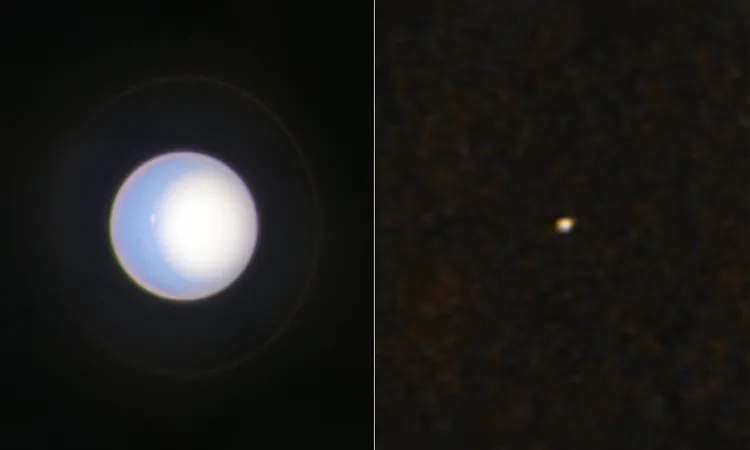
Revolutionary Eco-Friendly Solar Cells Break Efficiency Records – A Game Changer for Sustainable Energy!
2024-10-25
Author: Arjun
Introduction
In a world increasingly desperate for sustainable energy solutions, solar power continues to emerge as a leading contender in the fight against climate change. In 2023 alone, Spain saw a staggering 28% increase in installed solar photovoltaic capacity compared to the previous year, which now constitutes a remarkable 20.3% of the nation's total energy generation. This surge in adoption is not exclusive to Spain, with many Western countries following a similar trajectory, highlighting a pivotal shift toward renewable energy sources.
The Need for Innovation in Solar Technology
While solar panels have become more common and are lauded for their environmental benefits, there remains a pressing need for innovation in their materials and technology. Traditional solar cells often rely on non-sustainable elements, and there's a growing consensus in the scientific community that the next generation of solar technology should be lightweight, affordable, flexible, and environmentally friendly. This vision of solar harvesting—expanding beyond large-scale solar farms to power buildings, transportation, and even smart IoT devices—hinges on the development of more sustainable solar cell technologies.
Emerging Technology: Colloidal Silver Bismuth Sulfide Nanocrystal
A promising new alternative that is gaining traction is colloidal silver bismuth sulfide (AgBiS2) nanocrystal. This remarkable material boasts an exceptionally high absorption coefficient, making it an ideal candidate for ultra-thin solar absorbers. Researchers have been exploring ways to manufacture these solar cells more efficiently by transitioning from a complex multi-step deposition process to a simpler, single-step approach. The goal? To achieve high efficiency while minimizing material waste and production costs.
Challenges in Development
Since 2020, scientists have made strides in developing AgBiS2 nanocrystal inks. However, initial attempts faced challenges due to significant surface defects that hindered power conversion efficiency in solar cells. These surface defects played a detrimental role, trapping electrical charge carriers generated by sunlight and promoting their recombination, ultimately negatively impacting the overall device efficiency.
Breakthrough Innovation: P-DIP Strategy
The breakthrough came recently from a team of researchers at ICFO, led by ICREA Professor Gerasimos Konstantatos. Their innovative approach, detailed in the journal Energy & Environmental Science, introduced a post-deposition in situ passivation (P-DIP) strategy that significantly enhances surface passivation. This led to nanocrystal ink films with improved optoelectronic properties, resulting in solar cells with unprecedented power conversion efficiencies that even surpassed those produced by traditional multi-step methods.
Practical Implications
Dr. Jae Taek Oh, the study's first author, likened the process of effective surface passivation to smoothening a bumpy road for vehicles: “Just as repaving a road allows for smoother travel, our method aids in reducing obstacles that charge carriers face in the nanocrystal films.” Thanks to the P-DIP technique, the movement of charge carriers became significantly more efficient.
Conclusion and Future Prospects
This comprehensive methodology not only improved the quality and efficiency of the AgBiS2 nanocrystal films—achieving around 10% efficiency—but also underscored the potential of eco-friendly alternatives in solar cell technology. The team utilized a multifunctional molecular agent containing chlorine during the synthesis of the nanocrystal ink, which helped to stabilize and evenly disperse the particles, a crucial factor for achieving uniform coatings. As the world races toward a more sustainable future, the advancement represented by these new solar cells could be a cornerstone in the global transition to renewable energy. Perhaps soon, these game-changing eco-friendly solar solutions will not just be a vision but a tangible reality that powers our buildings, vehicles, and devices, proving that sustainable energy is not just an option but a necessity.




 Brasil (PT)
Brasil (PT)
 Canada (EN)
Canada (EN)
 Chile (ES)
Chile (ES)
 España (ES)
España (ES)
 France (FR)
France (FR)
 Hong Kong (EN)
Hong Kong (EN)
 Italia (IT)
Italia (IT)
 日本 (JA)
日本 (JA)
 Magyarország (HU)
Magyarország (HU)
 Norge (NO)
Norge (NO)
 Polska (PL)
Polska (PL)
 Schweiz (DE)
Schweiz (DE)
 Singapore (EN)
Singapore (EN)
 Sverige (SV)
Sverige (SV)
 Suomi (FI)
Suomi (FI)
 Türkiye (TR)
Türkiye (TR)